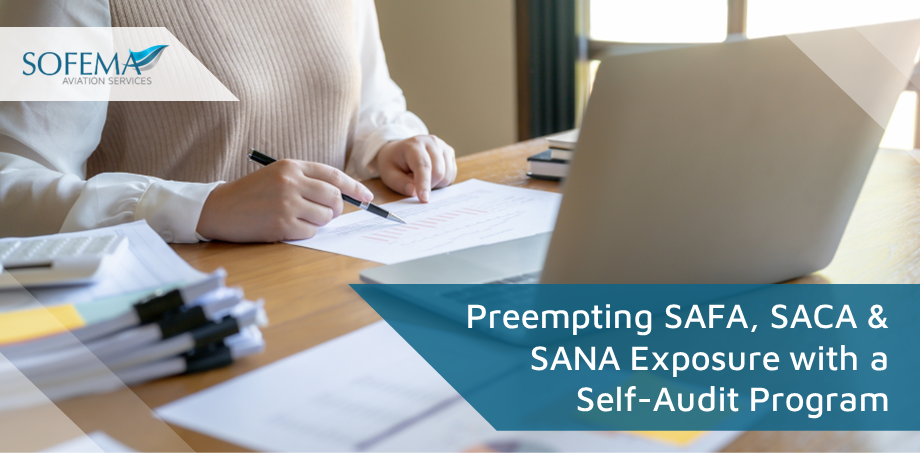Sofema Aviation Services (SAS) considers a process whereby an operator may elect to self-audit (Internal Audit Program) in anticipation of regulatory audits.
Internal Audit Program Introduction
SAFA (Safety Assessment of Foreign Aircraft) requires putting in place a mechanism to collect any information deemed useful to establish and maintain a high uniform level of civil aviation safety.
If during the Ramp Inspection, a deviation from the applicable Standards is established, it is considered a finding.
- There are three different categories of findings, depending on the impact the finding has on the safety of the aircraft and/or its occupants.
- Inspection checklist contains a total of 54 items.
o Of these checklist items, 24 relate to operational requirements (A items) to be checked on the flight deck, 14 items address safety and cabin items (B items), 12 items are concerning the aircraft condition (C items) and 3 items (D items) are related to the inspection of cargo and the cargo compartment.
- In case of any findings not related to the other items of the checklist, they may be administered by the E item (General) of the checklist.
Summary of Inspection Criteria
The purpose of a SAFA Ramp inspection is to check compliance with international standards (i.e. Chicago Convention, its Annexes, ICAO regional standards), and/or manufacturer standards which are the minimum standards to be observed by any aircraft in international navigation.
- When inspecting the technical condition of an aircraft, it should be checked against the aircraft certification and manufacturer standards.
- Compliance with national standards that are declared applicable to all operators flying to that Contracting State aerospace if referred to its AI.
Developing your own SAFA, SACA & SANA Audit Program
To say at the outset that this is an optional “elective” program whereby the organisation develops an internal audit program to continually validate all ICAO / EASA – SAFA/SANA compliances.
Option 1 – Small to Medium Fleets – To Perform a self-audit at least once / month (repeat throughout the year)
Option 2 – Medium to Large Fleets – To Sample, Fleet Aircraft to again perform one to two self-audits / month
Note: The purpose of the audit is twofold:
- To gain confidence in the continuing airworthiness and acceptability of the fleet
- To create an opportunity for a fleet follow-up inspection in the event that non-compliances are found during an inspection of any aircraft.
How to ensure you can pass a Ramp Inspection
Meet an incoming company aircraft at the home base – Is the flight deck tidy?
- Is Storage available for all required items (Including crew bags etc.) (Nothing must obstruct the exits.)
Can you locate all the required documents?
- What company Manuals are available
- Flight Manual / MEL current and up to date
- Insurance
- Certificate of Airworthiness
- Aircraft Registration & AOC
- Radio License
- Noise Certification
- Flight Planning Papers
- Mass and balance
- Performance calculations
- Software Configuration Status and Compliance
Next Steps
Follow this link to our Library to find & Download related documents for Free.
Sofema Aviation Services (SAS) www.sassofia.com and Sofema Online (SOL) www.sofemaonline.com provide regulatory compliant as well as vocational training courses please see the website or email team@sassofia.com for additional guidance.
Tags:
Auditing, aviation, Sofema Aviation Services, Audit, SAFA, SAS blogs, Safety Assessment of Community Aircraft (SACA), Safety Assessment of Foreign Aircraft (SAFA), Internal Audit Program, SACA, SANA





